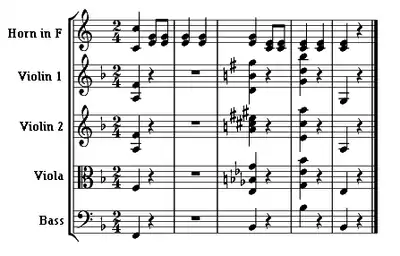List of polytonal pieces
List of pieces using polytonality and/or bitonality.
- Samuel Barber
- Symphony No. 2 (1944)
- Béla Bartók
- Mikrokosmos Volume 5 number 125: The opening (mm. 1-76) of "Boating", (actually bimodality) in which the right hand uses pitches of E♭ dorian and the left hand uses those of either G mixolydian or dorian[1]
- Mikrokosmos No. 105, "Playsong"[2]
- 44 Violin Duets, "Song of the Harvest" (1933)[3]
- Bagatelles (1908)[4] 1st Bagatelle, RH: C♯ minor, LH: C Phrygian.[5]
- Jeff Beal
- Theme from House of Cards[6]
- Benjamin Britten
- Sea Interludes (1945)[7]
- Fanfare for St Edmundsbury (1959)
- Folk Songs of the British Isles, Vol. 1, No. 6[4]
- Vicente García
- San Bá
- Alberto Ginastera
- Danzas Argentinas - 1. "Danza del viejo boyero" (1937), RH: white keys, LH: black keys[8]
- Philip Glass
- Symphony No. 2, used for ambiguity[9]
- Jerry Goldsmith
- Planet of the Apes (1968)
- Patton (1970)
- The Omen (1976)[10]
- Percy Grainger
- Gustav Holst
- The Planets (Neptune)
- Terzetto for Flute, Oboe and Viola
- Arthur Honegger
- Bruce Hornsby
- "What The Hell Happened" (from Halcyon Days, 2004)[11]
- Charles Ives
- Variations on "America" (1891-1892), polytonal interludes added 1909-1910[12]
- Adeste fidelis for organ (1897)[13]
- Sixty-seventh Psalm (1898–99)[4]
- Piano Sonata No. 2 (Ives) III. The Alcotts, presence of bitonality (right hand in B♭ major and left hand in A♭ major)[14]
- John Kander
- Cabaret (1966), in the Finale Ultimo
- Colin McPhee
- Concerto for Piano, with Wind Octette Acc. (1928)[15]
- Darius Milhaud[16]
- Scaramouche, in the first movement "Vif"
- Sorocaba, from Saudades Do Brasil
- Le Boeuf sur le toit
- String Quartet No.5 (1920)[17]
- Ennio Morricone
- The Untouchables (1987)
- Wolfgang Amadeus Mozart

Ein musikalischer Spass  Play
Play
- Sergei Prokofiev
- Lieutenant Kijé Suite (mov. V, "The Burial of Kijé")
- Sarcasms, Op. 17. The third movement uses two different key signatures for each hand.[18]
- Alfred Reed
- A Festival Prelude
- Julius Röntgen
- Symphony No. 9 "The Bitonal" (Sept 8, 1930)[19]
- Arnold Schoenberg
- "Gavotte", Suite for Piano Op. 25 (1923)[20]
- William Schuman
- George Washington Bridge[21]
- Igor Stravinsky[16]
- Petrushka, opening fanfare
- Symphony of Psalms - 3rd Movement
- Symphonies of Wind Instruments (1947), rehearsal No. 11[22]
- "Rite of Spring"
- Karol Szymanowski
- String Quartet No. 1 in C major Movement 3 (1917). Each part has its own key: Cello, C; Viola, 3 flats; Violin 2, 6 sharps; Violin 1, 3 sharps. See score.
- Jeff Wayne
- The War of the Worlds - "The Red Weed (Parts 1 & 2)" (B and G major)[23]
- John Williams
- Star Wars (1977)[10]
- John Zdechlik
Sources
- Stein, Deborah (2005). "Introduction to Musical Ambiguity" in Engaging Music: Essays in Music Analysis, p.82-3. New York: Oxford University Press. ISBN 0-19-517010-5.
- Kostka, Stefan and Payne, Dorothy (1995). Tonal Harmony, p.495. ISBN 0-07-300056-6.
- DeLone, et al. (1975). Aspects of 20th Century Music, p.339. ISBN 0-13-049346-5.
- Richardson, John (1999). Singing Archaeology: Philip Glass's Akhnaten, p.73. ISBN 9780819563422.
- Ross, Alex (2007). The Rest Is Noise: Listening to the Twentieth Century, p.83. ISBN 9780374249397.
- Wilkins, Margaret Lucy (2006). Creative Music Composition, p.78. ISBN 9780415974677.
- Hinson, Maurice (2000). Guide to the Pianist's Repertoire, p.334. ISBN 9780253336460.
- "Philip Glass : Symphony No. 2", ChesterNovello.com.
- Karlin, Fred and Wright, Rayburn (2004). On the Track: A Guide to Contemporary Film Scoring, p.359. ISBN 9780415941365.
- Diton, Robert (September 23, 2011). "Bruce Hornsby to bring the noise to Englewood", Examiner.com.
- Latham, Alison (2004). The Oxford Dictionary of Musical Works, p.173. ISBN 9780198610205.
- One of "2 Organ Pieces" (@IMSLP), published 1949
- Ives, Charles. "Piano Sonata No.2 'Concord, Mass., 1840–60'" (PDF). II. The Alcotts. imslp.org.
- Gagné, Nicole V. (2012). Historical Dictionary of Modern and Contemporary Classical Music, p.171. ISBN 9780810879621.
- Reti, Rudolph (1958). Tonality, Atonality, Pantonality: A study of some trends in twentieth century music, . Westport, Connecticut: Greenwood Press. ISBN 0-313-20478-0.
- See . Opens with themes in A, B♭ modal (or F?) and C simultaneously, for example.
- Encyclopædia Britannica, "Polytonality (music)".
- Gaudeamus. The life of Julius Röntgen (1855-1932). Composer and musician. Dr Jurjen Vis, Waanders Uitgevers Zwolle, 2007, Appendix 4, p.449
- Maconie, Robin (2005). Other Planets, p.71. ISBN 0-8108-5356-6. "Has distinctly polytonal tendencies."
- Swayne, Steve (2011). Orpheus in Manhattan: William Schuman and the Shaping of America's Musical Life, p.244. ISBN 9780195388527.
- Berry, Wallace (1976). Structural Functions in Music, p.183n1. ISBN 0-486-25384-8.
- Anatomy of a Musical: An Analysis of the Structure of Jeff Wayne’s Musical Version of The War of the Worlds
- Country Life, Volume 154, p.2015.
This article is issued from Wikipedia. The text is licensed under Creative Commons - Attribution - Sharealike. Additional terms may apply for the media files.